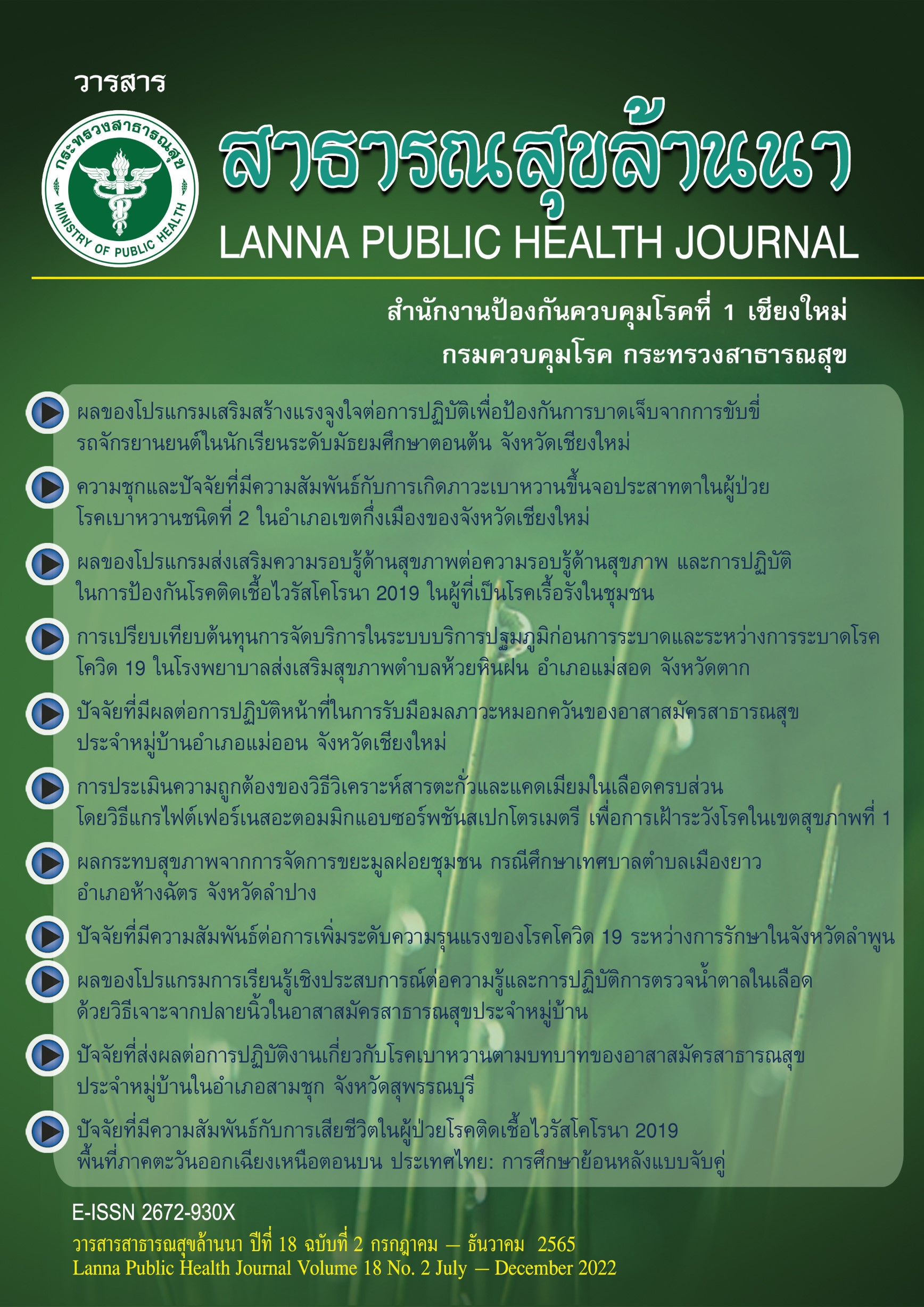ปัจจัยที่มีความสัมพันธ์ต่อการเพิ่มระดับความรุนแรงของโรคโควิด 19 ระหว่างการรักษาในจังหวัดลำพูน
คำสำคัญ:
โควิด 19, ปัจจัยเสี่ยง, ความรุนแรงของโรคบทคัดย่อ
การศึกษาเชิงพรรณนานี้มีวัตถุประสงค์เพื่อศึกษาปัจจัยที่ทำให้มีการเพิ่มขึ้นของระดับความรุนแรงของโรคโควิด 19 ในระหว่างการรักษาของผู้ป่วยโรคโควิด 19 ระหว่างเดือนเมษายนถึงพฤษภาคม พ.ศ.2564 ในโรงพยาบาลลำพูน กลุ่มตัวอย่างจำนวน 237 ราย ได้มาโดยการเลือกแบบเฉพาะเจาะจงตามเกณฑ์ที่กำหนด ทำการเก็บข้อมูลจากระบบบันทึกเวชระเบียนอิเล็กทรอนิกส์ของผู้ป่วยย้อนหลัง วิเคราะห์ข้อมูลโดยใช้สถิติเชิงพรรณนาและสถิติเชิงอนุมานโดยการวิเคราะห์ความสัมพันธ์แบบตัวแปรเชิงเดี่ยวและสถิติถดถอยพหุโลจิสติกส์ ผลการศึกษาพบว่า กลุ่มตัวอย่างเป็นเพศชาย ร้อยละ 54.00 อายุเฉลี่ย 34.98±14.81 ปี ไม่มีโรคประจำตัว ร้อยละ 78 ไม่สูบบุหรี่ ร้อยละ 97.89 มีอัตราการเต้นของหัวใจน้อยกว่า 100 ครั้งต่อนาที ร้อยละ 72.57 และพบว่าผู้ป่วยเป็นกลุ่มที่มีอาการและอาการแสดง ร้อยละ 82.70 ระยะเวลาอาการแสดงจนถึงได้รับการรักษาในโรงพยาบาลส่วนใหญ่ภายใน 48 ชั่วโมง ร้อยละ 74.26 พบรอยโรคในปอดตั้งแต่แรกรับ ร้อยละ 13.50 ได้รับยาฟาวิพิราเวียร์ ร้อยละ 21.94 และยาสเตียรอยด์ ร้อยละ 13.92 และพบว่า เพศชายมีโอกาสเพิ่มระดับความรุนแรงของโรคโควิด เป็น 4.52 เท่าของเพศหญิง ผู้ป่วยที่มีโรคประจำตัวมีโอกาสเพิ่มระดับความรุนแรงของโรคโควิด 19 เป็น 8.19 เท่าของผู้ป่วยที่ไม่มีโรคประจำตัว และผู้ป่วยที่มีอัตราการเต้นของหัวใจมากกว่า หรือเท่ากับ 100 ครั้ง/นาที มีโอกาสเพิ่มระดับความรุนแรงของโรคโควิด 19 เป็น 3.29 เท่าของผู้ป่วยที่มีอัตราการเต้นหัวใจน้อยกว่า 100 ครั้ง/นาที ดังนั้นเจ้าหน้าที่สาธารณสุขและผู้เกี่ยวข้องควรให้ความสำคัญในการดูแลผู้ป่วยโรคโควิด 19 มากขึ้น เพื่อลดความรุนแรงของโรคโควิด 19 ต่อไป
เอกสารอ้างอิง
กรมควบคุมโรค กระทรวงสาธารณสุข. (2564). สถานการณ์ผู้ป่วย COVID-19 ภายในประเทศ รายสัปดาห์ [ออนไลน์]. [สืบค้นเมื่อ 1 มิถุนายน 2564]; Available from: https://ddc.moph.go.th/covid19-dashboard/
Badawi, A., & Ryoo, S. G. (2016). Prevalence of comorbidities in the Middle East respiratory syndrome coronavirus (MERS-CoV): a systematic review and meta-analysis. International Journal of Infectious Diseases, 49, 129-133.
Bursac, Z., Gauss, C. H., Williams, D. K., & Hosmer, D. W. (2008). Purposeful selection of variables in logistic regression. Source Code for Biology and Medicine, 3(1), 1-8.
Ciceri, F., Castagna, A., Rovere-Querini, P. et al. (2020). Early predictors of clinical outcomes of COVID-19 outbreak in Milan, Italy. Clinical Immunology, 217, 1-8.
De Wit, E., Van Doremalen, N., Falzarano, D., & Munster, V. J. (2016). SARS and MERS: recent insights into emerging coronaviruses. Nature Reviews Microbiology, 14(8), 523-534.
Gao, Y. D., Ding, M., Dong, X. et al. (2021). Risk factors for severe and critically ill COVID-19 patients: a review. Allergy, 76(2), 428-455.
Gao, Z., Xu, Y., Sun, C. et al. (2021). A systematic review of asymptomatic infections with COVID-19. Journal of Microbiology, Immunology and Infection, 54(1), 12-16.
Huang, X., Wei, F., Hu, L., Wen, L., & Chen, K. (2020). Epidemiology and clinical characteristics of COVID-19. Archives of Iranian Medicine, 23(4), 268-271.
Jaillon, S., Berthenet, K., & Garlanda, C. (2019). Sexual dimorphism in innate immunity. Clinical Reviews in Allergy & Immunology, 56(3), 308-321.
Lotfi, M., Hamblin, M. R., & Rezaei, N. (2020). COVID-19: Transmission, prevention, and potential therapeutic opportunities. Clinica Chimica Acta, 508, 254-266.
Maloberti, A., Ughi, N., Bernasconi, D. P. et al. (2021). Heart Rate in Patients with SARS-CoV-2 Infection: Prevalence of High Values at Discharge and Relationship with Disease Severity. Journal of Clinical Medicine, 10(23), 5590.
Patel, U., Malik, P., Usman, M. S. et al. (2020). Age-adjusted risk factors associated with mortality and mechanical ventilation utilization amongst COVID-19 hospitalizations-a systematic review and meta-analysis. SN Comprehensive Clinical Medicine, 2(10), 1740-1749.
Porzionato, A., Emmi, A., Barbon, S. et al. (2020). Sympathetic activation: a potential link between comorbidities and COVID-19. The FEBS Journal, 287(17), 3681-3688.
Rattanaumpawan, P., Jirajariyavej, S., Lerdlamyong, K., Palavutitotai, N., & Saiyarin, J. (2022). Real-World Effectiveness and Optimal Dosage of Favipiravir for Treatment of COVID-19: Results from a Multicenter Observational Study in Thailand. Antibiotics, 11(6), 805.
Sepandi, M., Taghdir, M., Alimohamadi, Y., Afrashteh, S., & Hosamirudsari, H. (2020). Factors associated with mortality in COVID-19 patients: a systematic review and meta-analysis. Iranian Journal of Public Health, 49(7), 1211-1221.
Shereen, M. A., Khan, S., Kazmi, A., Bashir, N., & Siddique, R. (2020). COVID-19 infection: Emergence, transmission, and characteristics of human coronaviruses. Journal of Advanced Research, 24, 91-98.
Wilder-Smith, A., Teleman, M. D., Heng, B. H., Earnest, A., Ling, A. E., & Leo, Y. S. (2005). Asymptomatic SARS coronavirus infection among healthcare workers, Singapore. Emerging Infectious Diseases, 11(7), 1142-1145.
Zhang, T., Huang, W. S., Guan, W. et al. (2020). Risk factors and predictors associated with the severity of COVID-19 in China: a systematic review, meta-analysis, and meta-regression. Journal of Thoracic Disease, 12(12), 7429-7441.
Zhou, Y., Chi, J., Lv, W., & Wang, Y. (2021). Obesity and diabetes as high-risk factors for severe coronavirus disease 2019 (Covid-19). Diabetes/Metabolism Research and Reviews, 37(2), 1-14.








